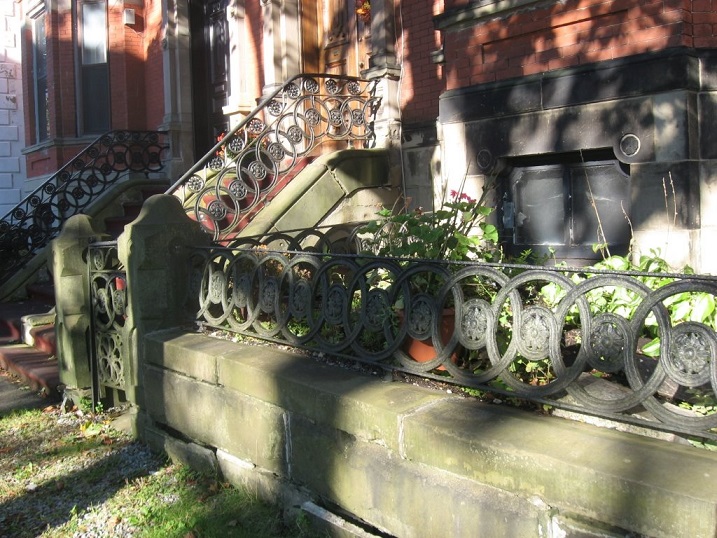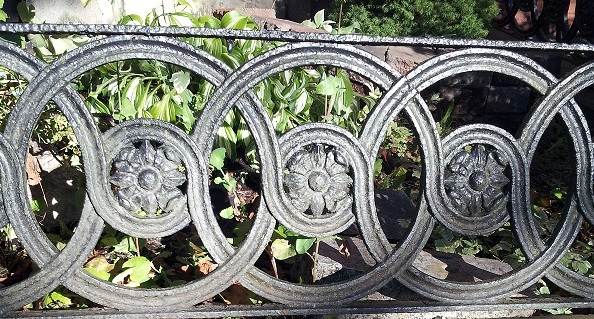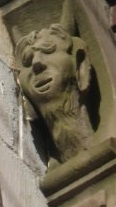
Historic Places
What would the Cookies of the Girl Guides of Canada have to do with
the design of a Fence in Saint John?
What is a Gargoyle?
What would the Cookies of the Girl Guides of Canada have to do with
the design of a Fence in Saint John?
What is a Gargoyle?
Throughout the fall, all the wood for the kitchen stove had been ranked in the wood shed along with a stack of cedar kindling.
The furnace wood, the potatoes, the vegetables and Mum’s preserves and pickles were in the cellar.
On this day, Dad was trying to finish readying the house for winter by banking all around the exterior with sawdust and putting on the storm windows. But a problem arose when he brought the wooden storm door from overhead in the shed. It seems he had been intending to build a new one as this one was showing signs of rotting boards but time had slipped away on him.
He got out the fold-up wooden measuring tape and measured the opening, which I wrote on the back of last month’s calendar page.
I didn’t understand as he mumbled that the builder of this old house in the early 1800s did not have a square or level in his tool box.
Some planed boards were fetched from the barn. The small glass window, hinges and latch from the old door were recycled to the new one.
We held the door in place as Dad nailed on the hinge. But he missed the first nail and hit his thumb and the air turned blue. He rushed into the house to soak his thumb in cold water. I thought I should go see what was going on and let go of the door. With a crash the door landed on the cement step and the window broke.
As I looked at the pictures of heritage homes at www.historicplaces.ca, I wondered how they were readied for winter and if the children participated in the task.
The Canadian Register of Historic Places website is not just about the design and history of the building in all provinces of Canada but gives information on the families who called these houses home.
The Frederick G. Spencer Residence with its large cornice and a pedimented portico was built in 1914 at 41 Orange Street in Saint John by William Kenneth Haley of Haley Brothers & Co. It was ready for occupancy in 1919. Spencer first entered the tailoring business of his grandfather’s at the age of 16. Four years later, he married singer Helen Craigle. He lost interest in the tailoring business and became involved in the entertainment industry. He managed the Canadian concert tours of a number of famous performers. He opened and operated one of Saint John’s earliest theatres located on Charlotte Street known as “The Unique”.
The George Nixon Building, built circa 1878 is a three-storey brick Italianate commercial/residential building with two shops at the storefront level and apartments above. It is located on King Street in Saint John. George Nixon’s wall paper store - the first in Saint John - was established in 1855 and operated from this location for nearly 100 consecutive years.
Thomas A. Rankine, established a prominent biscuit manufacturing business located on Mill and George Streets in 1826. His sons’ residences on 210 and 212 Germain Street, Saint John, had a circular floral pattern on the cast iron fence and gate that reflects the mould of one of the Rankines' most famous cookies, specifically designed for the Girl Guides of Canada. Gargoyles are stone heads with an opening at the mouth that deflects water from the roof through the mouth and makes a gargling sound that gives the head the name gargoyle. I believe this building has the only true gargoyles on a house in Saint John, as they transport the water from the eaves.
Senator Dever Residence, 5 Chipman Hill, Saint John was built circa 1850 and was once part of the Ward Chipman estate. James Dever was born at Bellyshannon, Ireland in 1825. He came to Saint John as a child with his parents and was educated here. He was called to the senate as a representative of the Saint John District and of the Roman Catholic denomination in 1868 and attended every session until his death in 1904
The first owner of the saltbox house design built circa 1890 at 131 George Street, Dalhousie was Andrew Loggie, a prominent New Brunswick merchant, who, with his brother, Robert, founded the firm A&R Loggie Company Limited in 1881 in Loggieville on the Miramichi. The brothers started by selling fish door to door, and branched out into fish packing and freezing from Maine to the North Shore of New Brunswick. Andrew moved to Dalhousie in 1890 to run the A&R Loggie store on William Street.
Meadow Lodge, a two-storey, twenty-room, wooden residence was built in the Shingle Style in 1909 for Frederick W. Thompson, Vice President and Managing Director of Ogilvie Flour Mills as a summer residence in St. Andrews. It was designed by famed Montreal architects Edward and William Maxwell. The Maxwells were also responsible for furnishing and decorating Meadow Lodge, as well as laying out the grounds for the driveway, gardening, tennis court, and stable.
Erected circa 1845, the Yeamans House is a three-storey wood-frame steeply gabled house situated on Yeamans Road, adjacent to Newcastle Creek in the Village of Minto. Lt. Col. John Yeamans, a loyalist from New York came to New Brunswick in 1783. His son Peter (R.P.), a justice of the peace and road commissioner, built the present house around 1845.
At one time, church services were held here before the local Anglican church was completed in 1846.
Although, I enjoyed all the information on the heritage buildings, I was intrigued with the Gibson Family Plot in the Marysville area of Fredericton. The plot consists of a large central white granite monument encircled by 27 smaller burial markers, many of intricate design.
The distinct circular arrangement of graves is unusual and unique. Of interest to me also was this town was originally called Rankin Mills. Boss Gibson had the name changed to Marysville to honour his wife, Mary (Robinson) Gibson.
I learned much from the Glossary of Terms, such as ashlar stone has been cut square and dressed. A bellcast roof flares out at the eaves. A palladian window is a three-part window consisting of a tall centre window, usually round-headed, flanked by two shorter, narrower windows. Portico means a covered porch or walkway supported by columns.
Family researchers are not the only ones looking at the heritage buildings, as students have searched out and photographed ones suitable for their Stonehammer geopark related assignments.
By the way, I did not find any mention of family members getting the houses ready for winter but I did find lots of information on the past owners of more than 12,000 heritage buildings in the online Canadian Register of Historic Places.
*******************************************************************************************************


**************************

Gargoyles are stone heads with an opening at the mouth that deflects water from the roof through the mouth and makes a gargling sound that gives the head the name gargoyle. (Joan Pearce Collection)
|
New and Used Genealogical and Historical books of New Brunswick for sale. |
Back to Home of rubycusack dot com